Assessing Coastal Degradation Through Spatiotemporal Earth Observation Data Cubes Analytics and Multidimensional Visualization
Abstract
1. Introduction
- This work introduces the Ocean-DC tool as an approach of EO data harmonization and homogenization.
- This work addresses current Big Data challenges through the Ocean-DC tool implementation.
- The Ocean-DC products provide a robust architecture for EO data management (i.e., storage, processing, and distribution).
- Through the case study, we investigate the use of advance analytics tools for monitoring coastal degradation.
- This work investigates the visualization of EO data in high-dimensional data structures.
2. Related Works
3. Proposed Methodology
- Extreme wind speeds and waves: These data can be collected from climate or meteorological models (i.e., CORDEX mission [13]) or in situ data collection using local station (i.e., usually from national observatories).
- Sea level: These data can be expressed as seasonal or annual variability, considering the local tectonics, subsidence, or uplifting of the coast. Tidal trends are also included in these data category. The World Climate Research Program (WCRP) [31] can be a source for such data.
- Climate/Meteorological variables: The data can include climate/meteorological phenomena, variables and parameters such as temperature, humidity, precipitation, barometric forcing, etc. These data are mostly provided by models [13]. However, some of these parameters, such as temperature, can be collected, calculated or provided in EO data (i.e., TIRS bands in Landsat-8/9).
- Coastal geology: Coastal geology can be monitored using the SWIR [32] bands of EO data (i.e., Landsat-8/9 and Sentinel-2) or geological maps.
- Very high resolution bathymetry data: Such data can be downloaded from GEBCO [33]. The current version of the Ocean-DC framework does not process these data; however, they can be used raw, combined with Ocean-DC products for visualization enhancement.
- Vegetation in the coastal zone: By calculating the NDVI or NDWI EO products, it is possible to monitor coastal vegetation both underwater and onshore. Vegetation can stabilize the seabed and coastal dunes [34].
- Monitoring of deltas, lagoons, vegetation, and marshes: These parameters can be monitored using EO data (i.e., Landsat-8/9 and Sentinel-2) [35].
- River discharges, and seasonal river-borne sediment load: Similarly, these parameters can be monitored using EO data (i.e., Landsat-8/9 and Sentinel-2) [36].
3.1. Data Collection
3.2. Data Harmonization
3.3. Post Processing and Storage Management
3.4. Visualization
4. Case Study: Periodic Monitoring of the Port of Heraklion
4.1. Experimental Setup
Evaluation Metrics
- Storage Ratio (SR): The SR is calculated by dividing the Ocean-DC product’s size with the raw product’s size, when both of these products contain the same spectral information (i.e., bands). This metric provides insights related to storage management.
- Time Performance Ratio (TPR): This metric is calculated by comparing the time needed to calculate the products by standard methods (e.g., manual approach using GIS software or automation which exists in the GIS software).
- Products Quality/Resolution (PQR = low, medium, high): This metric compares the products created from the Ocean-DC framework with those created products by standard methods. The quality estimated using photo interpretation techniques [46] (i.e., pattern recognition and color differences), which are commonly used in remote sensing.
- Visualization Results (VisRes = low, medium, high): This metric evaluates the different dimensional products in terms of visualization. The evaluation criteria are the easiness of detection of the different entities (i.e., vegetation, urban, and coastal areas) in the images, without further processing. VisRes evaluated by using photo-interpretation techniques [46] similar to PQR.
- Identifying Critical Conditions (ICC = easy, medium, hard): This metric is an extension of VisRes. In this case, different dates are visualized together for identifying trends related to seasonal or yearly changes and identifying the outliers or critical conditions of potential degradation based on photo-interpretation techniques [36,46].
4.2. Experimental Results
5. Discussion
6. Conclusions
- This work presents the Ocean-DC framework as an emerging technology comparable to current state-of-the-art data cubes’ generators like Google Earth Engine and Open Data Cubes.
- In comparison with the state-of-the-art data cubes’ generators, the Ocean-DC framework is supported by all major OS and can be installed easily in any system, even in virtual machines. In addition, it supports the processing of CORDEX and WCRP datasets without preprocessing.
- In terms of the output products, the Ocean-DC generates ready-to-use data cubes in NetCDF format without necessarily needing post-processing. The generated EO products can be accesses, shared, and visualized easily in any GIS software as VRTs or a geoserver via standardized formats (i.e., WMS/WFS).
- A limitation to the current Ocean-DC product can be the unavailability to upscale (i.e., super-resolution) the CORDEX and WCRP data, which need further processing outside the framework.
- For both EO and non-EO data, the Ocean-DC framework uses boundary geometries to clip the original data over the area of interest (i.e., exclude unnecessary information). A natural limitation to this process can be the selection of huge areas of interest, which can increase the storage size of final products compared to the raw structure.
- While processing EO data, the Ocean-DC framework calculates several remote sensing products automatically by recognizing the correct data type. This characteristic severely minimizes the needed post-processing time (or download time if using current existing alternatives to obtain similar ready-to-use data).
- Considering the case study results, the Ocean-DC framework can be an intuitive solution for ocean and maritime periodic monitoring, as the generated products can be visualized using different multidimensional analysis approaches, such as photo-interpretation like pattern recognition, differences in colors, etc. In these approaches, the correct selection of a color map can indicate successfully critical areas and extreme situations that can cause coastal and maritime degradation.
Author Contributions
Funding
Data Availability Statement
Conflicts of Interest
References
- Halder, B.; Ameen, A.M.S.; Bandyopadhyay, J.; Khedher, K.M.; Yaseen, Z.M. The impact of climate change on land degradation along with shoreline migration in Ghoramara Island, India. Phys. Chem. Earth Parts A/B/C 2022, 126, 103135. [Google Scholar] [CrossRef]
- Guerra-Mera, J.C.; Sabando García, Á.R.; Pin-Mera, M.G.; Rodríguez-Díaz, J.M.; Castañeda-Valdés, A. Assessment of atmospheric corrosivity in coastal zones: Case study in port Lopez, Manabí, Ecuador. Case Stud. Chem. Environ. Eng. 2024, 9, 100703. [Google Scholar] [CrossRef]
- Petrişor, A.I.; Hamma, W.; Nguyen, H.D.; Randazzo, G.; Muzirafuti, A.; Stan, M.I.; Tran, V.T.; Aştefănoaiei, R.; Bui, Q.T.; Vintilă, D.F.; et al. Degradation of Coastlines under the Pressure of Urbanization and Tourism: Evidence on the Change of Land Systems from Europe, Asia and Africa. Land 2020, 9, 275. [Google Scholar] [CrossRef]
- Andrews, N.; Bennett, N.J.; Le Billon, P.; Green, S.J.; Cisneros-Montemayor, A.M.; Amongin, S.; Gray, N.J.; Sumaila, U.R. Oil, fisheries and coastal communities: A review of impacts on the environment, livelihoods, space and governance. Energy Res. Soc. Sci. 2021, 75, 102009. [Google Scholar] [CrossRef]
- Mejjad, N.; Rossi, A.; Pavel, A.B. The coastal tourism industry in the Mediterranean: A critical review of the socio-economic and environmental pressures & impacts. Tour. Manag. Perspect. 2022, 44, 101007. [Google Scholar] [CrossRef]
- Bethel, B.J.; Buravleva, Y.; Tang, D. Blue Economy and Blue Activities: Opportunities, Challenges, and Recommendations for The Bahamas. Water 2021, 13, 1399. [Google Scholar] [CrossRef]
- Fudge, M.; Ogier, E.; Alexander, K.A. Marine and coastal places: Wellbeing in a blue economy. Environ. Sci. Policy 2023, 144, 64–73. [Google Scholar] [CrossRef]
- Apostolopoulos, D.; Nikolakopoulos, K. A review and meta-analysis of remote sensing data, GIS methods, materials and indices used for monitoring the coastline evolution over the last twenty years. Eur. J. Remote Sens. 2021, 54, 240–265. [Google Scholar] [CrossRef]
- Vitousek, S.; Buscombe, D.; Vos, K.; Barnard, P.L.; Ritchie, A.C.; Warrick, J.A. The future of coastal monitoring through satellite remote sensing. Camb. Prism. Coast. Futures 2023, 1, e10. [Google Scholar] [CrossRef]
- Chen, J.; Chen, S.; Fu, R.; Li, D.; Jiang, H.; Wang, C.; Peng, Y.; Jia, K.; Hicks, B.J. Remote Sensing Big Data for Water Environment Monitoring: Current Status, Challenges, and Future Prospects. Earth Future 2022, 10, e2021EF002289. [Google Scholar] [CrossRef]
- Google. Google Earth Engine. 2025. Available online: https://earthengine.google.com/ (accessed on 23 June 2025).
- Open Data Cubes Team. Open Data Cubes. 2025. Available online: https://www.opendatacube.org/ (accessed on 23 June 2025).
- CORDEX. Coordinate Regional Climate Downscaling Experiment. 2025. Available online: https://cordex.org/ (accessed on 23 June 2025).
- Sarawagi, S.; Agrawal, R.; Megiddo, N. Discovery-driven exploration of OLAP data cubes. In Proceedings of the Advances in Database Technology—EDBT’98: 6th International Conference on Extending Database Technology, Valencia, Spain, 23–27 March 1998; Proceedings 6. Springer: Berlin/Heidelberg, Germany, 1998; pp. 168–182. [Google Scholar]
- Gray, J.; Chaudhuri, S.; Bosworth, A.; Layman, A.; Reichart, D.; Venkatrao, M.; Pellow, F.; Pirahesh, H. Data cube: A relational aggregation operator generalizing group-by, cross-tab, and sub-totals. Data Min. Knowl. Discov. 1997, 1, 29–53. [Google Scholar] [CrossRef]
- Francia, M.; Marcel, P.; Peralta, V.; Rizzi, S. Enhancing cubes with models to describe multidimensional data. Inf. Syst. Front. 2022, 24, 31–48. [Google Scholar] [CrossRef]
- Leprince, J.; Miller, C.; Zeiler, W. Data mining cubes for buildings, a generic framework for multidimensional analytics of building performance data. Energy Build. 2021, 248, 111195. [Google Scholar] [CrossRef]
- Song, Y.; Fan, Y.; Li, X.; Ji, Y. Multidimensional visualization of transit smartcard data using space–time plots and data cubes. Transportation 2018, 45, 311–333. [Google Scholar] [CrossRef]
- Giuliani, G.; Chatenoux, B.; Benvenuti, A.; Lacroix, P.; Santoro, M.; Mazzetti, P. Monitoring land degradation at national level using satellite Earth Observation time-series data to support SDG15–exploring the potential of data cube. Big Earth Data 2020, 4, 3–22. [Google Scholar] [CrossRef]
- Miranda, F.; Lins, L.; Klosowski, J.T.; Silva, C.T. Topkube: A rank-aware data cube for real-time exploration of spatiotemporal data. IEEE Trans. Vis. Comput. Graph. 2017, 24, 1394–1407. [Google Scholar] [CrossRef]
- Tardío, R.; Maté, A.; Trujillo, J. A new big data benchmark for OLAP cube design using data pre-aggregation techniques. Appl. Sci. 2020, 10, 8674. [Google Scholar] [CrossRef]
- Majeed, A.; Zhang, Y.; Ren, S.; Lv, J.; Peng, T.; Waqar, S.; Yin, E. A big data-driven framework for sustainable and smart additive manufacturing. Robot.-Comput.-Integr. Manuf. 2021, 67, 102026. [Google Scholar] [CrossRef]
- Ferreira, K.R.; Queiroz, G.R.; Vinhas, L.; Marujo, R.F.B.; Simoes, R.E.O.; Picoli, M.C.A.; Camara, G.; Cartaxo, R.; Gomes, V.C.F.; Santos, L.A.; et al. Earth Observation Data Cubes for Brazil: Requirements, Methodology and Products. Remote Sens. 2020, 12, 4033. [Google Scholar] [CrossRef]
- Poussin, C.; Guigoz, Y.; Palazzi, E.; Terzago, S.; Chatenoux, B.; Giuliani, G. Snow Cover Evolution in the Gran Paradiso National Park, Italian Alps, Using the Earth Observation Data Cube. Data 2019, 4, 138. [Google Scholar] [CrossRef]
- Chatenoux, B.; Richard, J.P.; Small, D.; Roeoesli, C.; Wingate, V.; Poussin, C.; Rodila, D.; Peduzzi, P.; Steinmeier, C.; Ginzler, C.; et al. The Swiss data cube, analysis ready data archive using earth observations of Switzerland. Sci. Data 2021, 8, 295. [Google Scholar] [CrossRef]
- Giuliani, G.; Chatenoux, B.; Piller, T.; Moser, F.; Lacroix, P. Data Cube on Demand (DCoD): Generating an earth observation Data Cube anywhere in the world. Int. J. Appl. Earth Obs. Geoinf. 2020, 87, 102035. [Google Scholar] [CrossRef]
- Lewis, A.; Oliver, S.; Lymburner, L.; Evans, B.; Wyborn, L.; Mueller, N.; Raevksi, G.; Hooke, J.; Woodcock, R.; Sixsmith, J.; et al. The Australian Geoscience Data Cube—Foundations and lessons learned. Remote Sens. Environ. 2017, 202, 276–292. [Google Scholar] [CrossRef]
- Kavouras, I.; Rallis, I.; Doulamis, N.; Doulamis, A. Ocean-DC: An analysis ready data cube framework for environmental and climate change monitoring over the port areas. In Proceedings of the 17th International Conference on PErvasive Technologies Related to Assistive Environments, Crete, Greece, 26–28 June 2024; pp. 412–419. [Google Scholar]
- EU Commission. HORIZON EUROPE, OCEANIDS Project: User-Driven Applications and Tools for Climate-Informed Maritime Spatial Planning and Integrated Seascape Management, Towards a Resilient & Inclusive Blue Economy. 2025. Available online: https://cordis.europa.eu/project/id/101112919 (accessed on 23 June 2025).
- European Commission. Variables that Could Be Useful for Managing Coastal Erosion-Suggestions from Nic Flemming. 2025. Available online: https://maritime-forum.ec.europa.eu/contents/variables-could-be-useful-managing-coastal-erosion-suggestions-nic-flemming_en?prefLang=sv (accessed on 23 June 2025).
- WCRP. World Climate Research Program. 2025. Available online: https://www.wcrp-climate.org/ (accessed on 23 June 2025).
- Carvalho, M.; Cardoso-Fernandes, J.; González, F.J.; Teodoro, A.C. Comparative Performance of Sentinel-2 and Landsat-9 Data for Raw Materials’ Exploration Onshore and in Coastal Areas. Remote Sens. 2025, 17, 305. [Google Scholar] [CrossRef]
- GEBCO-British Oceanographic Data Centre. Gridded Bathymetry Data. 2025. Available online: https://www.gebco.net/data-products/gridded-bathymetry-data (accessed on 23 June 2025).
- Marzialetti, F.; Giulio, S.; Malavasi, M.; Sperandii, M.G.; Acosta, A.T.R.; Carranza, M.L. Capturing Coastal Dune Natural Vegetation Types Using a Phenology-Based Mapping Approach: The Potential of Sentinel-2. Remote Sens. 2019, 11, 1506. [Google Scholar] [CrossRef]
- Sebastiá-Frasquet, M.T.; Aguilar-Maldonado, J.A.; Santamaría-Del-Ángel, E.; Estornell, J. Sentinel 2 Analysis of Turbidity Patterns in a Coastal Lagoon. Remote Sens. 2019, 11, 2926. [Google Scholar] [CrossRef]
- Filippucci, P.; Brocca, L.; Bonafoni, S.; Saltalippi, C.; Wagner, W.; Tarpanelli, A. Sentinel-2 high-resolution data for river discharge monitoring. Remote Sens. Environ. 2022, 281, 113255. [Google Scholar] [CrossRef]
- USGS. EarthExplorer. 2025. Available online: https://earthexplorer.usgs.gov/ (accessed on 23 June 2025).
- EU, Copernicus, ESA. Copernicus Data Space. 2025. Available online: https://dataspace.copernicus.eu/ (accessed on 23 June 2025).
- NASA. MODIS Data. 2025. Available online: https://modis.gsfc.nasa.gov/data/ (accessed on 23 June 2025).
- Xarray. Xarray Documentation. 2024. Available online: https://docs.xarray.dev/en/stable/ (accessed on 23 June 2025).
- Corteva Agriscience. Rioxarray Documentation. 2025. Available online: https://corteva.github.io/rioxarray/stable/ (accessed on 23 June 2025).
- Rasterio Team. Rasterio Documentation. 2025. Available online: https://rasterio.readthedocs.io/en/stable/ (accessed on 23 June 2025).
- Heraklion Port Authority, S.A. Heraklion Port Authority. 2025. Available online: https://portheraklion.gr/index.php/en/ (accessed on 23 June 2025).
- Kavouras, I. Oceanids Data Cubes Code. 2025. Available online: https://gitlab.com/JohnCrabs/oceanids-data-cube-app (accessed on 23 June 2025).
- JohnCrabs. Ocean-DC Framework. 2024. Available online: https://gitlab.com/JohnCrabs/oceanides_data_cubes/-/tree/main/src?ref_type=heads (accessed on 23 June 2025).
- Bianchetti, R.A.; MacEachren, A.M. Cognitive Themes Emerging from Air Photo Interpretation Texts Published to 1960. Isprs Int. J.-Geo-Inf. 2015, 4, 551–571. [Google Scholar] [CrossRef]
- Acuña-Ruz, T.; Uribe, D.; Taylor, R.; Amézquita, L.; Guzmán, M.C.; Merrill, J.; Martínez, P.; Voisin, L.; Mattar B., C. Anthropogenic marine debris over beaches: Spectral characterization for remote sensing applications. Remote Sens. Environ. 2018, 217, 309–322. [Google Scholar] [CrossRef]
- Milewski, R.; Schmid, T.; Chabrillat, S.; Jiménez, M.; Escribano, P.; Pelayo, M.; Ben-Dor, E. Analyses of the Impact of Soil Conditions and Soil Degradation on Vegetation Vitality and Crop Productivity Based on Airborne Hyperspectral VNIR–SWIR–TIR Data in a Semi-Arid Rainfed Agricultural Area (Camarena, Central Spain). Remote Sens. 2022, 14, 5131. [Google Scholar] [CrossRef]
- de Araújo Queiroz, H.A.; Gonçalves, R.M.; Mishra, M. Characterizing global satellite-based indicators for coastal vulnerability to erosion management as exemplified by a regional level analysis from Northeast Brazil. Sci. Total Environ. 2022, 817, 152849. [Google Scholar] [CrossRef] [PubMed]
- C, S.; Alsolai, H.; Allafi, R.; Arasi, M.A. Integrated image segmentation techniques for high-resolution coastal habitat mapping: Advancing remote sensing for coastal ecosystem assessment. J. South Am. Earth Sci. 2025, 159, 105526. [Google Scholar] [CrossRef]
- Wicaksono, A.; Wicaksono, P. Geometric accuracy assessment for shoreline derived from NDWI, MNDWI, and AWEI transformation on various coastal physical typology in Jepara Regency using Landsat 8 OLI imagery in 2018. Geoplanning J. Geomat. Plan 2019, 6, 55–72. [Google Scholar] [CrossRef]
- Balogun, A.L.; Yekeen, S.T.; Pradhan, B.; Althuwaynee, O.F. Spatio-Temporal Analysis of Oil Spill Impact and Recovery Pattern of Coastal Vegetation and Wetland Using Multispectral Satellite Landsat 8-OLI Imagery and Machine Learning Models. Remote Sens. 2020, 12, 1225. [Google Scholar] [CrossRef]
- Kavouras, I.; Sardis, E.; Protopapadakis, E.; Rallis, I.; Doulamis, A.; Doulamis, N. A Low-Cost Gamified Urban Planning Methodology Enhanced with Co-Creation and Participatory Approaches. Sustainability 2023, 15, 2297. [Google Scholar] [CrossRef]
- Kavouras, I.; Rallis, I.; Sardis, E.; Protopapadakis, E.; Doulamis, A.; Doulamis, N. Empowering Communities Through Gamified Urban Design Solutions. Smart Cities 2025, 8, 44. [Google Scholar] [CrossRef]
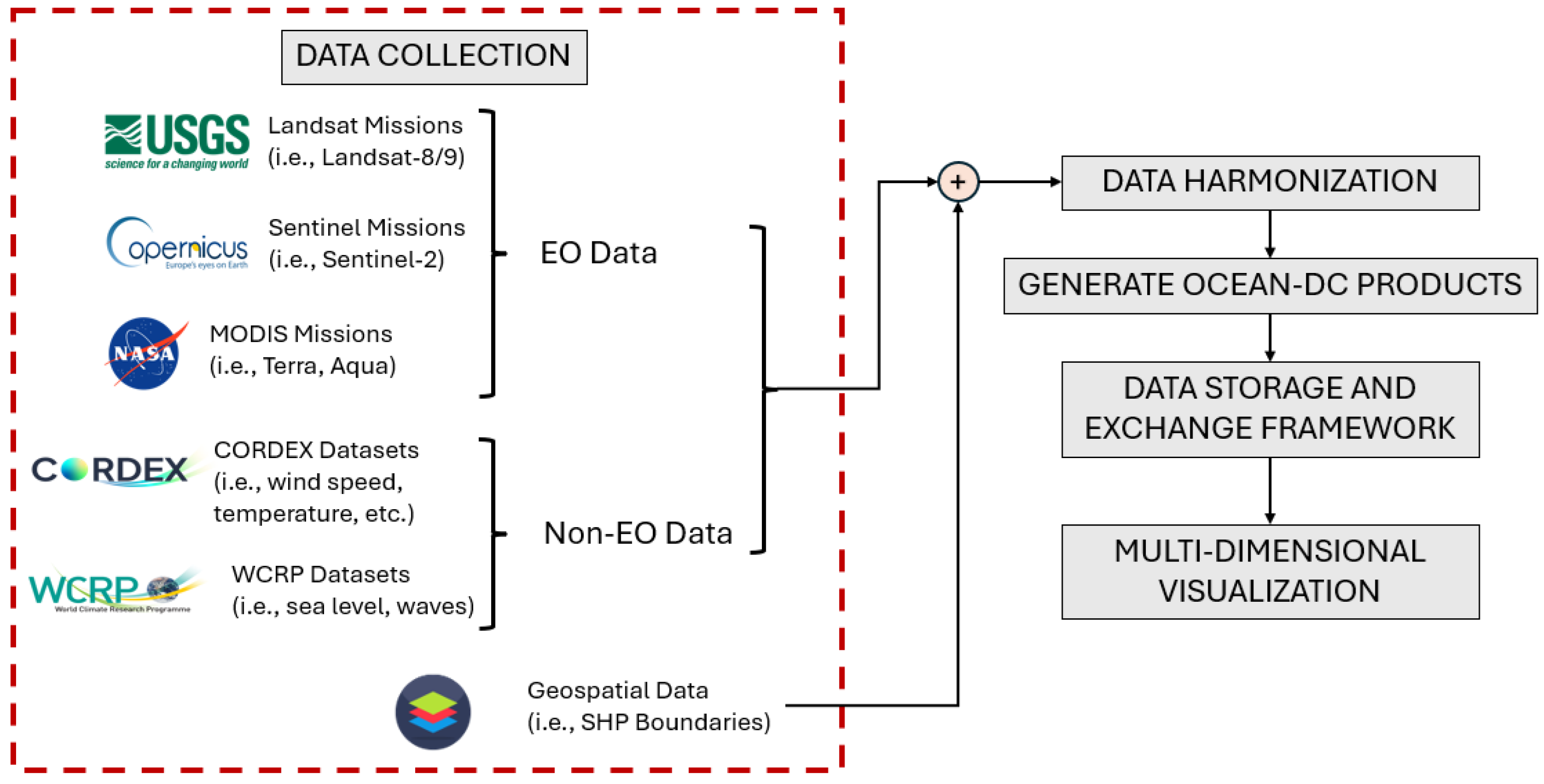


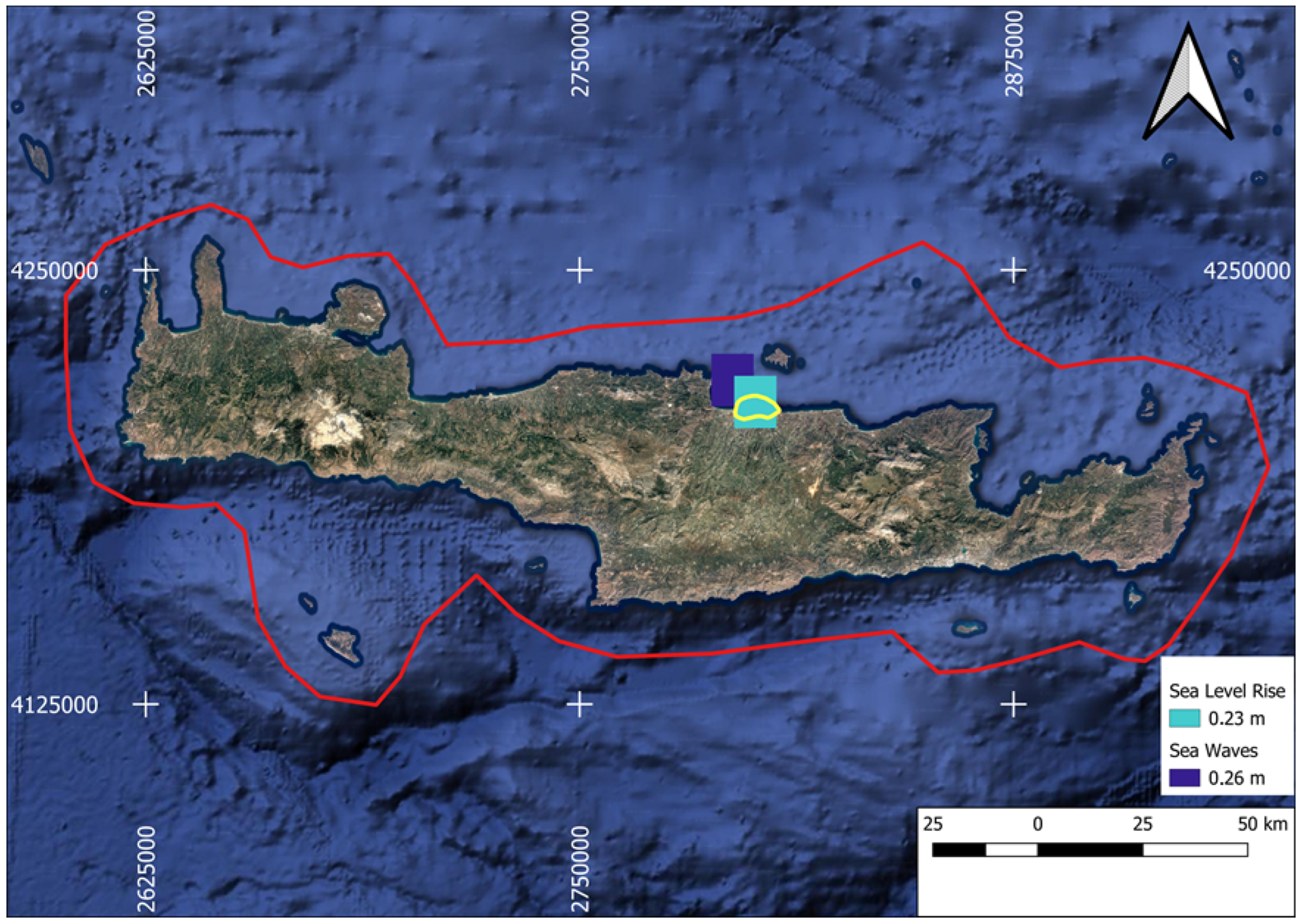
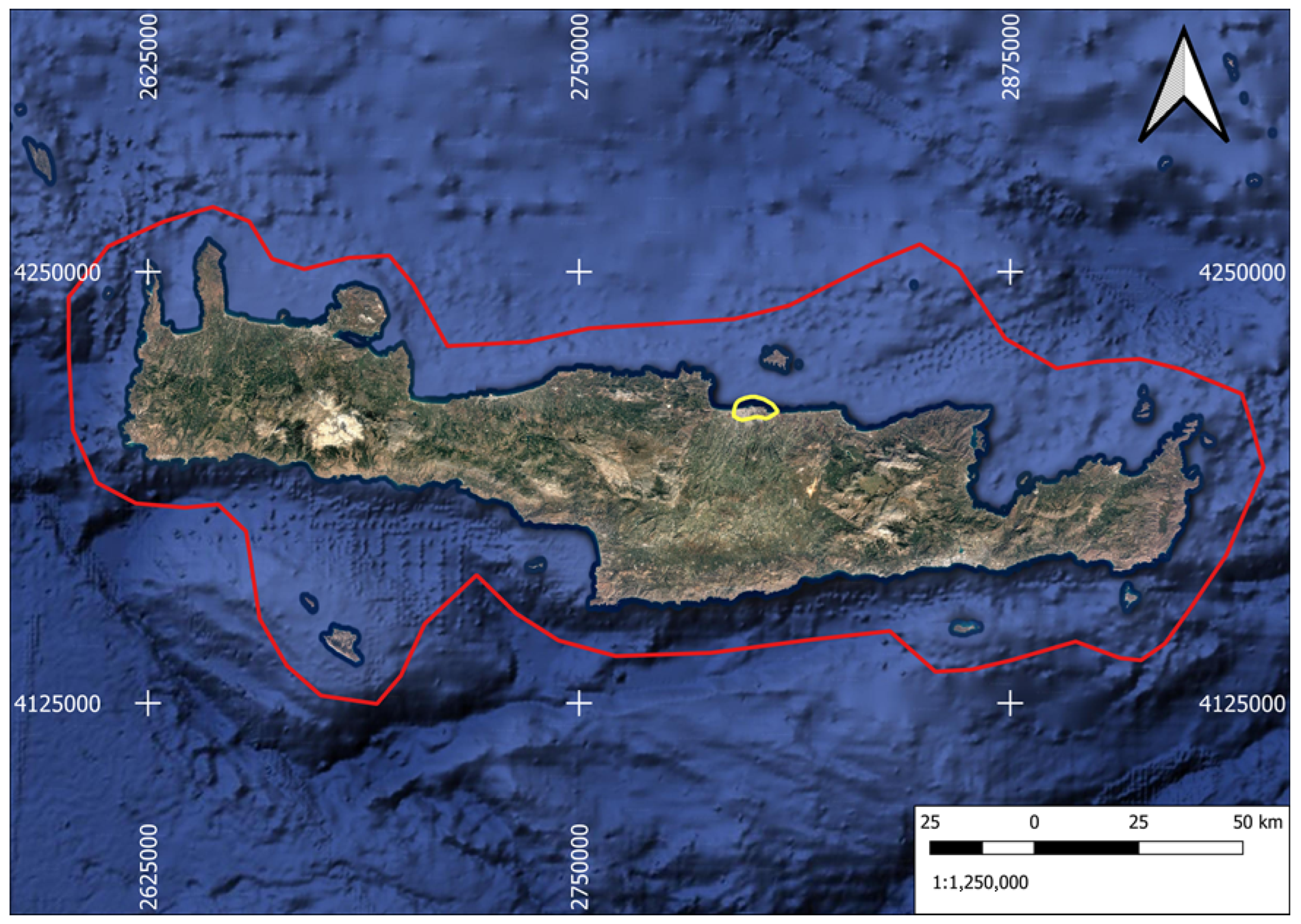
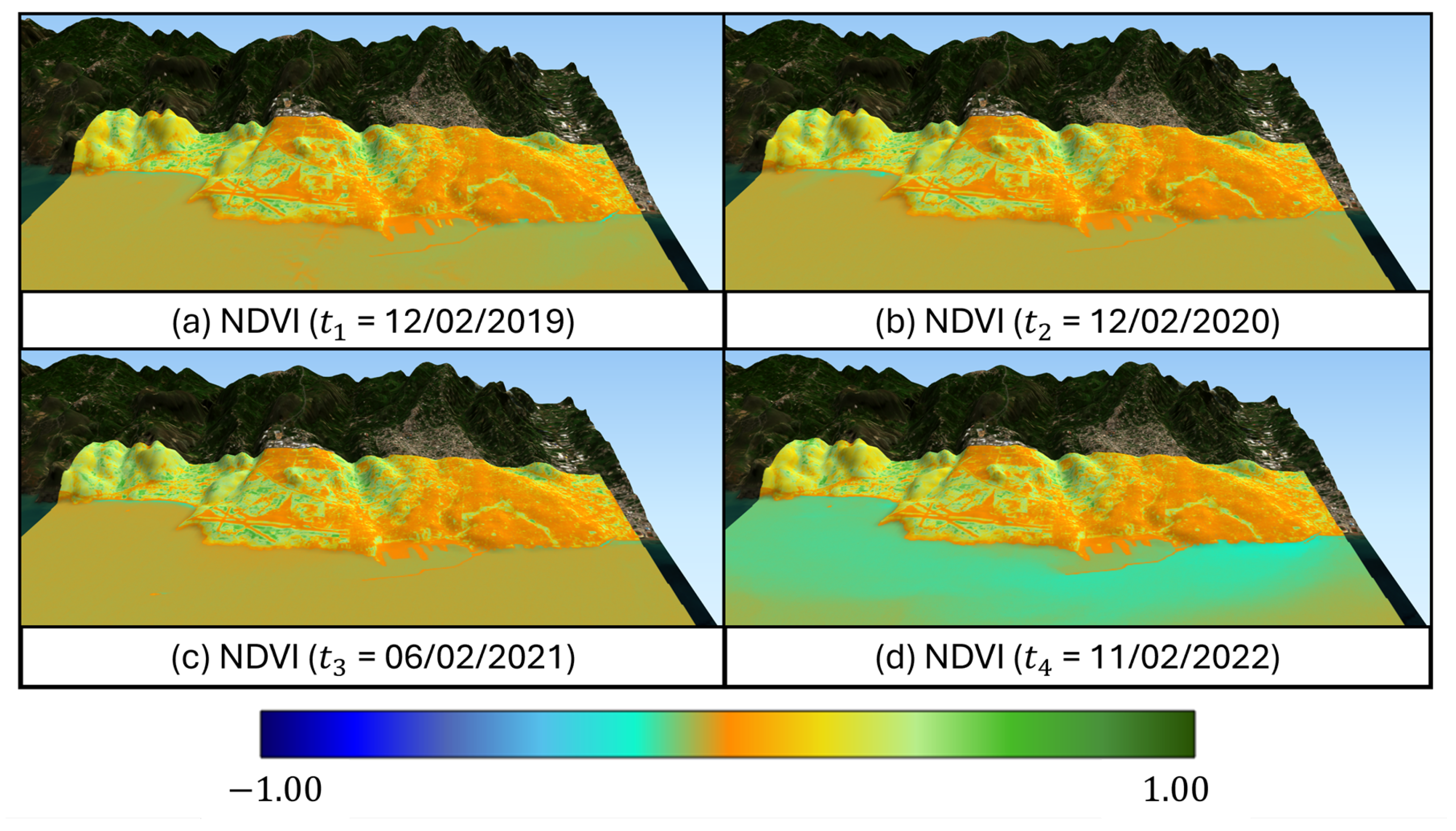
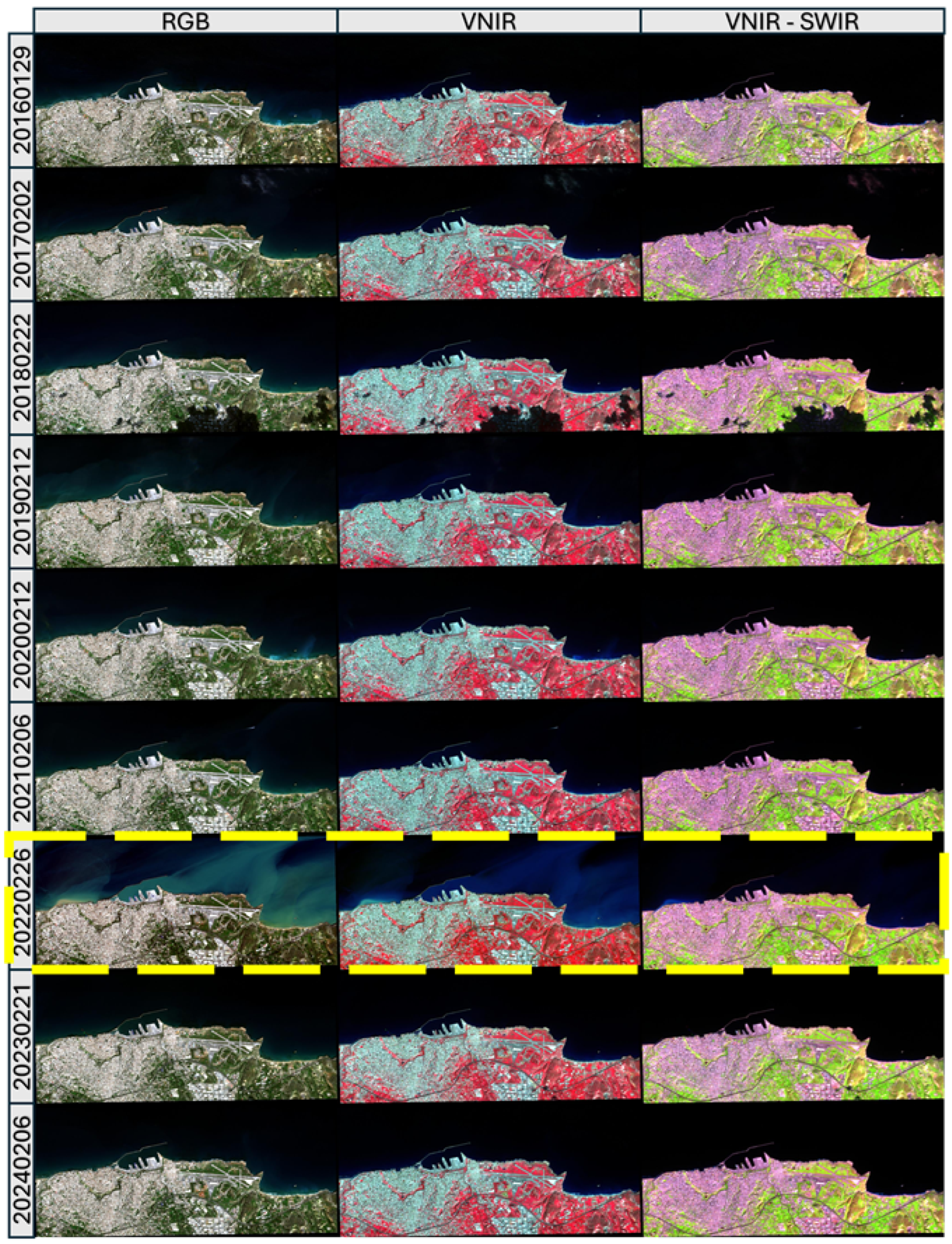
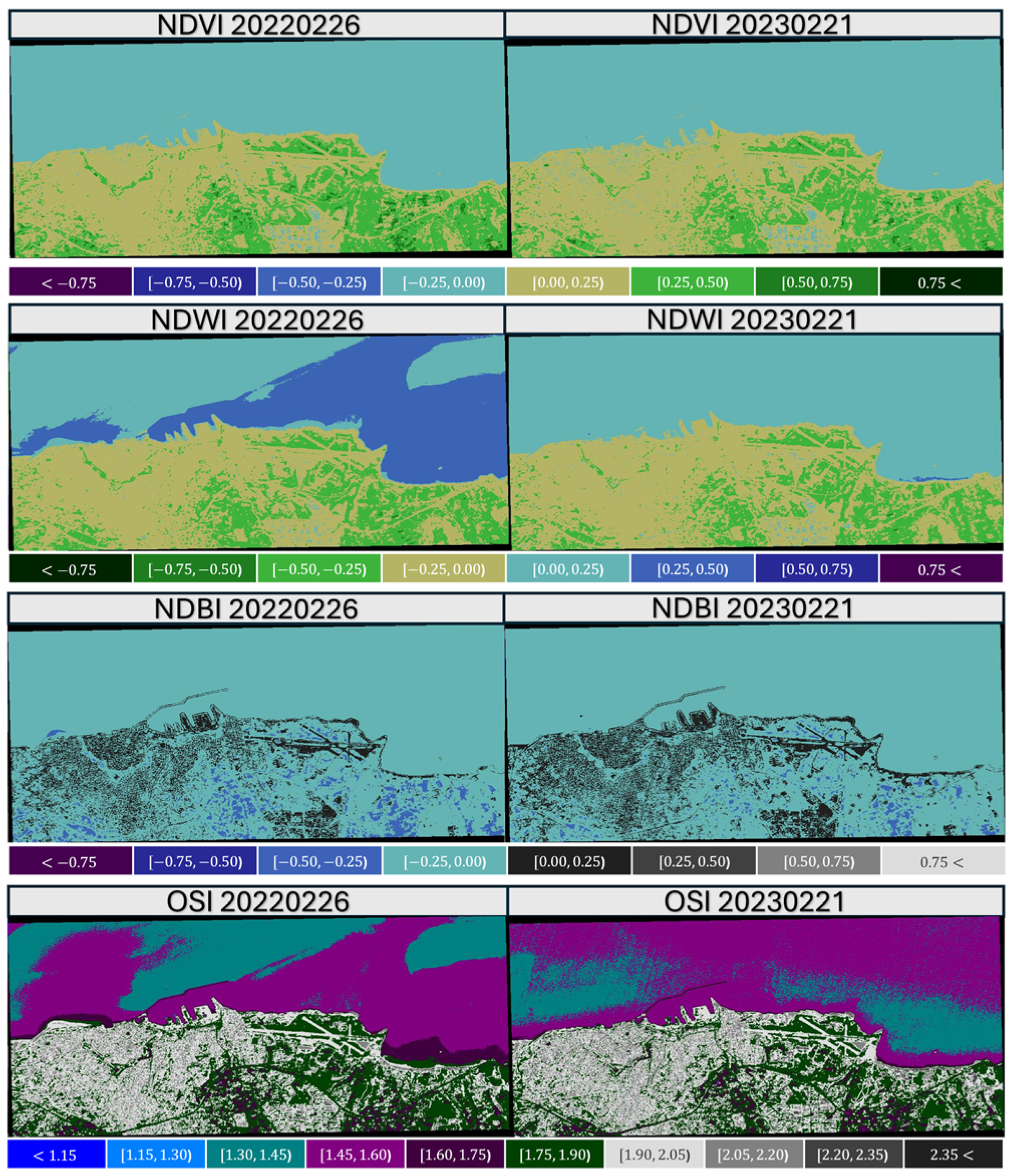

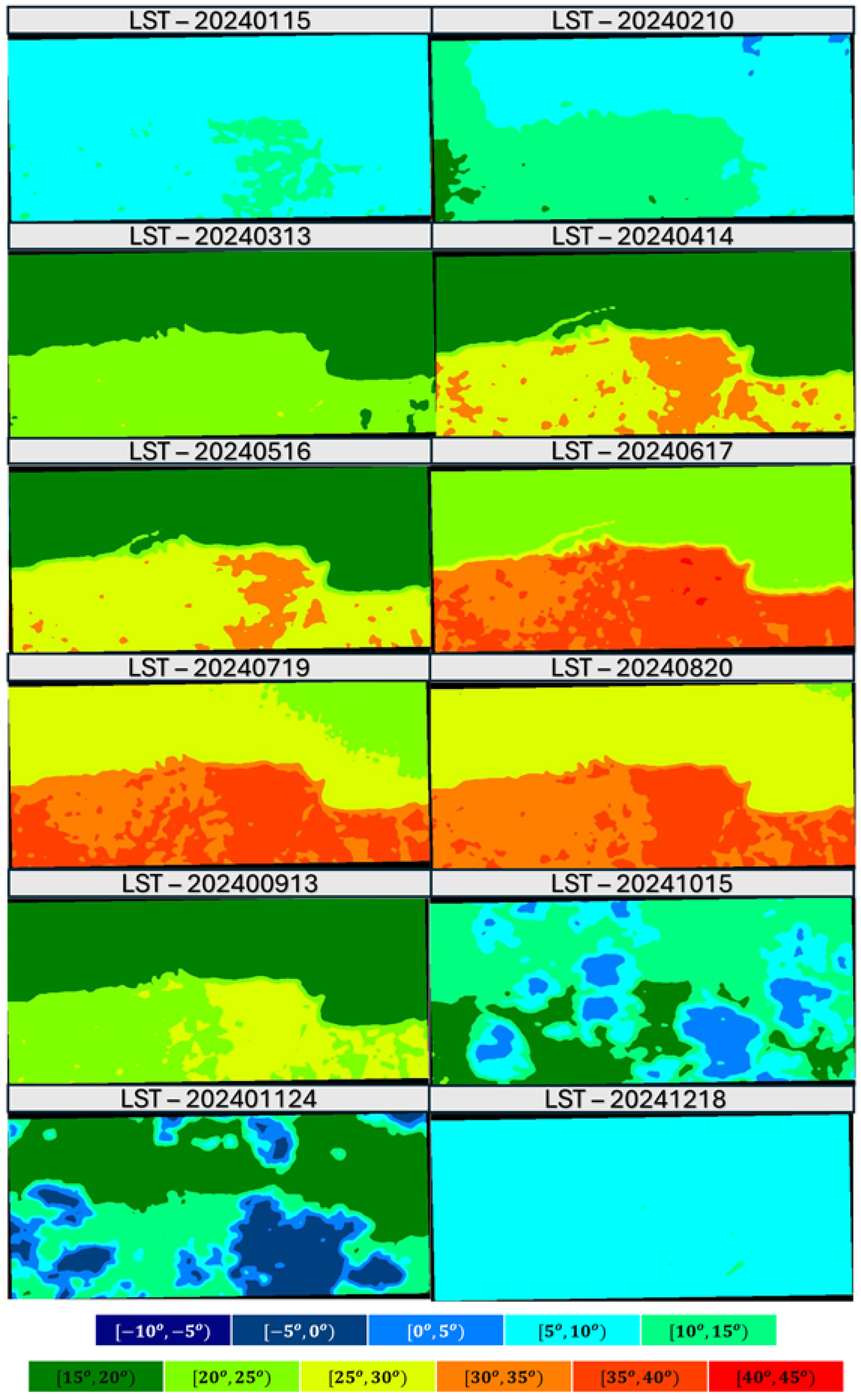
| Data Type | Product Name | Description | Resolution | Data Source |
|---|---|---|---|---|
| EO | Landsat Mission | Landsat missions, operating since 1972, provide continuous Earth observation data, capturing multispectral and thermal imagery. They can be used to monitor coastlines, map habitats like mangroves, assess water quality (e.g., turbidity, chlorophyll), and track temperature anomalies. With free, long-term data, Landsat supports sustainable marine management. | Moderate resolution (15 m/px, 30 m/px, 100 m/px) | USGS [37] |
| EO | Sentinel Mission | The Sentinel missions, part of ESA’s Copernicus program, deliver high-resolution Earth observation data. Sentinel-2 maps coastal land cover and water quality, while Sentinel-3 monitors sea surface temperature and ocean color. Their frequent revisits and open data support shoreline tracking, sediment plume detection, and algal bloom monitoring. | Moderate to High resolutions (5 m/px, 10 m/px, 20 m/px, 25 m/px, 60 m/px) | Copernicus Data Space [38] |
| EO | MODIS Mission | NASA’s MODIS sensors, on Terra and Aqua satellites since 1999, provide daily global data for coastal monitoring. They track sea surface temperature, ocean color, chlorophyll, and sediment transport. While coarser than Sentinel or Landsat, MODIS excels at detecting algal blooms, erosion, and turbidity changes | Low resolution (250 m/px, 500 m/px, 1 km/px) | NASA [39] |
| non-EO | CORDEX Projections (RCP4.5, RCP8.5, Historical) | CORDEX delivers high-resolution regional climate projections for impact studies. Using global model data, it offers historical (1950–2005), RCP4.5 (moderate emissions), and RCP8.5 (high emissions) scenarios. These help analyze temperature, precipitation, and extreme events, aiding coastal assessments of sea-level rise, heatwaves, and ocean-atmosphere changes for adaptation planning. | High-resolution (0.25°, approx. 12.5 km/px) | CORDEX [13] |
| non-EO | Sea Waves | The WCRP drives global wave climate modeling through CMIP and COWCLIP, producing historical and projected wave data (height, period, direction). This helps assess climate change impacts on coastal erosion, infrastructure, navigation, and coastal management under various emissions scenarios. | Point Data | WCRP [31] |
| non-EO | Sea Level | The WCRP advances sea level research through initiatives like its Sea Level Grand Challenge and CMIP models. It provides historical and projected sea level data (including thermal expansion and ice melt) to assess coastal risks, guide adaptation strategies, and support resilient infrastructure planning for vulnerable communities. | Point Data | WCRP [31] |
| non-EO | DEM, Bathymetry | DEM and Bathymetry data can be used for providing elevation information, which can be used for generating higher-dimensional visualization products. | Typical resolutions: 15′, 30′ | USGS [37] |
| non-EO | Shapefile Geometries | These data can be used for bounding the area of interest. | Self Generated |
| Data Type | Product Name | Description of Use | Data Source |
|---|---|---|---|
| EO | Sentinel-2 | Sentinel-2 products are similar to Landsat-8/9 but in higher resolution. Common remote sensing indices that can be calculated and used for coastal and maritime monitoring are the following: (a) NDVI (Normalized Difference Vegetation Index), (b) NDWI (Normalized Difference Water Index), (c) WRI (Water Ratio Index), (d) NDBI (Normalized Difference Build-Up Ratio) and (e) OSI (Oil Spill Index) | Copernicus Data Space [38] |
| EO | Landsat-8/9 | Landsat-8/9 products can be used for monitoring coastline and maritime region by calculating several well-known remote sensing indices like NDVI, NDWI, WRI, etc. Moreover, its thermal bands can be used to calculate Land/Sea Surface Temperature. | USGS [37] |
| non-EO | SRTM 1 Arc-Second Global DEM | The DEM is used for visualizing the data in 3D space. In this case study, it is used as the 4th dimension over the 3D Ocean-DC products. | USGS [37] |
| non-EO | Shapefile Geometries | These data can be used for bounding the area of interest and clipping the EO data. | Self Generated |
| Satellite Mission | Data Date Range | Data Raw Size [GB] | Size of Product Containing Only Raw Bands [GB] | SR of Product Containing Only Raw Bands [%] | Size of Product Containing All Bands (Raw and Calculated) [GB] | SR of Product Containing All Bands (Raw and Calculated) [%] |
|---|---|---|---|---|---|---|
| Sentinel-2 | 1 January 2016 to 31 December 2024 | 70.0 | 3.0 | 4.3% (decreased by 96.7%) | 11.0 | 15.7% (decreased by 84.3%) |
| Landsat-8/9 | 1 January 2024 to 31 December 2024 | 11.0 | 0.14 | 1.3% (decreased by 98.7%) | 0.50 | 4.5% (decreased by 95.5%) |
| Satellite Mission | Data Date Range | Data Raw Size [GB] | Size of Product Containing Only Raw Bands [GB] | SR of Product Containing Only Raw Bands [%] | Size of Product Containing All Bands (Raw and Calculated) [GB] | SR of Product Containing All Bands (Raw and Calculated) [%] |
|---|---|---|---|---|---|---|
| Sentinel-2 | 1 January 2016 to 31 December 2024 | 70.0 | 390.0 | 557.1% (increased by 457.1%) | 1540.0 | 2200.0% (increased by 2100.0%) |
| Landsat-8/9 | 1 January 2024 to 31 December 2024 | 11.0 | 50.0 | 454.5% (increased by 354.5%) | 198.0 | 1800.0% (increased by 1700.0%) |
Disclaimer/Publisher’s Note: The statements, opinions and data contained in all publications are solely those of the individual author(s) and contributor(s) and not of MDPI and/or the editor(s). MDPI and/or the editor(s) disclaim responsibility for any injury to people or property resulting from any ideas, methods, instructions or products referred to in the content. |
© 2025 by the authors. Licensee MDPI, Basel, Switzerland. This article is an open access article distributed under the terms and conditions of the Creative Commons Attribution (CC BY) license (https://creativecommons.org/licenses/by/4.0/).
Share and Cite
Kavouras, I.; Rallis, I.; Bakalos, N.; Doulamis, A. Assessing Coastal Degradation Through Spatiotemporal Earth Observation Data Cubes Analytics and Multidimensional Visualization. J. Mar. Sci. Eng. 2025, 13, 1239. https://doi.org/10.3390/jmse13071239
Kavouras I, Rallis I, Bakalos N, Doulamis A. Assessing Coastal Degradation Through Spatiotemporal Earth Observation Data Cubes Analytics and Multidimensional Visualization. Journal of Marine Science and Engineering. 2025; 13(7):1239. https://doi.org/10.3390/jmse13071239
Chicago/Turabian StyleKavouras, Ioannis, Ioannis Rallis, Nikolaos Bakalos, and Anastasios Doulamis. 2025. "Assessing Coastal Degradation Through Spatiotemporal Earth Observation Data Cubes Analytics and Multidimensional Visualization" Journal of Marine Science and Engineering 13, no. 7: 1239. https://doi.org/10.3390/jmse13071239
APA StyleKavouras, I., Rallis, I., Bakalos, N., & Doulamis, A. (2025). Assessing Coastal Degradation Through Spatiotemporal Earth Observation Data Cubes Analytics and Multidimensional Visualization. Journal of Marine Science and Engineering, 13(7), 1239. https://doi.org/10.3390/jmse13071239







